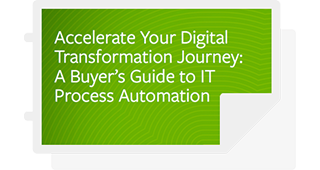IT process automation (ITPA) can make it much faster and more efficient to manage infrastructure and operations. In the process, ITPA can deliver a number of strategic advantages, including accelerating an organization’s digital transformation. In spite of all the potential of ITPA however, determining the best path forward isn’t necessarily very clear cut for decision makers. Part of the challenge is that the ITPA market includes quite a few tools and solutions, which can vary substantially in their approaches, strengths, and weaknesses. How do you determine which solution and approach is best for your organization? Read on to learn more.
In the following sections, I take a look at some of the different approaches available currently, and I detail how these differences can determine whether or not your organization achieves its business and operational objectives.
Task Automation is not ITPA—and Why the Distinction Matters
Task-level automation refers to the process of automating specific, discrete efforts. However, task-level automation is limited in its potential. Simply automating a specific task can reduce some manual efforts, but it can’t deliver top-level business objectives like enhancing compliance or reducing incident escalations.
On the other hand, ITPA automates and orchestrates entire IT processes across multiple functions and domains. ITPA often requires the combination of disparate management tools, as well as predefined workflows, advanced capabilities like machine learning, and more. Compared to task automation, ITPA is far more powerful because it enables your teams to better align IT services with the needs of the business. ITPA can help your teams improve the speed, accuracy, and effectiveness of IT service delivery. With ITPA, your organization can realize the following benefits:
- Reduced costs. Automating entire workflows and complex, interconnected processes reduces the need for human intervention and the need to escalate issues to more expensive, high-level staff members.
- Enhanced business agility. Through ITPA, IT teams can move from being a cost center to being a generator of business value. ITPA can help you manage change more effectively, deliver more innovative services, and speed issue resolution.
- Improved user experiences and service levels. User requests can be handled faster through automated self-service, without needing skilled IT staff to be involved. By reducing the need for manual intervention in IT processes, ITPA increases accuracy while improving responsiveness.
- Decreased risk. Through ITPA, your teams can establish the standardized processes that promote more consistent and efficient compliance with regulatory mandates and security policies. ITPA can help your organization reduce the potential for errors, streamline approvals, and enhance monitoring. With these capabilities, you can establish more granular governance, more frequent and accurate infrastructure audits, and better security.
What capabilities should you look for when evaluating ITPA offerings?
As decision makers evaluate ITPA alternatives, it is important to focus on the following critical capabilities:
Simplicity
An ITPA solution should be straightforward to set up. It should also deliver the rich, pre-packaged capabilities that speed time to value. The better a solution’s capabilities in this regard, the better your organization’s chances of realizing your cost reduction, productivity, and compliance goals.
It is essential that solutions simplify the process of setting up automation. Look for solutions that offer predefined workflow templates, actions, and connectors. By establishing automated coordination of workflows, teams can realize these objectives:
- Ensure events are detected and remediated sooner, which enhances quality of service.
- Institute more infrastructure checks and updates, which helps boost compliance.
- Simplify change management, which improves productivity and user satisfaction.
Orchestration focus
It is vital to find an integrated platform that enables an automation-first strategy. Your teams need a solution that supports the creation of workflows that span applications, platforms, and tools. With a strong ITPA solution, your team can orchestrate critical activities in order to maximize compliance, security, and efficiency.
By enabling orchestration across domains and functions, ITPA solutions enable your teams to address business challenges that extend beyond isolated efficiency issues. For example, solutions can employ advanced machine-learning and artificial-intelligence technologies in order to make orchestrated processes “smart”—leveraging historical and real-time data in order to address potential issues before they occur.
Broad integration
An advanced ITPA and orchestration solution must offer the flexibility needed to bridge the gaps between systems, platforms, and domains. To close the automation loop, a solution must integrate seamlessly with a range of technologies, including tools for event management, configuration management, virtualization, service desks, security, and cloud management. By offering prebuilt connections for relevant management and automation systems, ITPA solutions can simplify deployment and help your organization fully leverage existing resources and investments.
Want to learn more about key differences between ITPA offerings and what you should consider in your evaluation? Please be sure to access a copy of our buyer’s guide.







